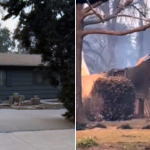Los Angeles, one of the most known and popular cities in the United States of America and home to the country’s film and television industry, Hollywood, has been burning for the past week due to wildfires. At least five people have been killed and thousands of homes have been gutted in wildfires that have ravaged multiple parts of Los Angeles in California – the most populous state of the US.
The wildfires started on Tuesday and have spread enough to engulf hundreds of acres including houses, forcing the evacuation of thousands. Hollywood celebrities too, haven’t been spared from this horror. Stars including Paris Hilton and Billy Crystal have lost their homes due to the raging wildfires. Besides, more than 137,000 residents in different neighborhoods of Los Angeles city have been ordered to evacuate as the fires, continue to rapidly spread, fuelled by high winds.
What started the fire?
According to the California Department of Forestry and Fire Protection (Cal Fire), the first fire started in the Pacific Palisades neighborhood of Los Angeles at 10:30 am on Tuesday. By Wednesday evening, the fires had spread to the iconic Hollywood Hills.
The City of Pasadena has issued an urgent alert concerning unsafe drinking water in areas impacted by recent evacuations due to the Eaton Fire. According to a statement from the city, the Pasadena Water and Power system may be compromised by “debris and elevated turbidity,” prompting officials to advise residents against consuming tap water.
Firefighters spent days doing whatever possible to fight fires across the county as strong winds and low humidity made for difficult conditions.

What was the reason behind the wildfires?
Investigators are still trying to find out the exact trigger for the worst firestorm in recent memory, but a combination of factors might have created conditions optimal for a fire.
Daniel Swain, a climate scientist at the University of California, Los Angeles, said on a livestream, “We really haven’t seen a season as dry as this one following a season as wet as the previous one – all of that extra abundant growth of grass and vegetation followed immediately by a wind event of this magnitude while it’s still so incredibly dry.”
California generally experiences wildfires during June and July, and they can run until October, but the blaze has defied the calendar this year, erupting in January – the coldest of the winter months.
The even larger Palisades fire, the Eaton fire remains totally uncontained. Meanwhile, the Sunset fire that has been menacing the well-known Hollywood Hills area has started to shrink but is not yet contained. Evacuation orders for the Hollywood Hills West area have been lifted.
Southern California, the site of the fires, has been experiencing drought conditions and has not seen significant rainfall for months. According to the US Drought Monitor, Last year less than four percent of California was affected by drought compared with nearly 60 percent this year.
Climate change has contributed to an increase in the frequency, season length and burned area of wildfires, according to a report by the US Environmental Protection Agency (EPA).
Nearly 2,000 structures are known to have been destroyed – including houses and schools, and businesses on the iconic Sunset Boulevard. A fire ecologist has told the BBC that “entire neighbourhoods… have been wiped out”.
So, dry conditions aided by Santa Ana winds – dry and hot winds common in the area – most likely caused the wildfires.
The dry desert air moves from the interior of the region towards the coast and offshore. It contributes to wildfires because it significantly reduces humidity in the environment due to its dry nature. This causes vegetation to become very dehydrated and susceptible to fire. Under these circumstances, any spark can start a fire, be it from a cigarette butt, vehicle or power line.
Santa Ana winds have been associated with extreme wildfires in California in the past, including the Woolsey fire in November 2018, which killed three people and razed 1,600 structures.

The forecast:
US government research is unequivocal in linking climate change to larger and more severe wildfires in the western United States. As per the National Oceanic and Atmospheric Administration, “Climate change, including increased heat, extended drought, and a thirsty atmosphere, has been a key driver in increasing the risk and extent of wildfires in the western United States.”
The insurance industry fears this could prove to be one of the costliest wildfire outbreaks in US history, with insured losses expected above $8bn (£6.5bn) due to the high value of properties in the paths of the blazes.
There is a glimmer of hope for firefighters, as the fire weather outlook for southern California has been downgraded from “extremely critical” to “critical”.
However, BBC weather forecaster Sarah Keith-Lucas says there is no rain forecast in the area for at least the next week, meaning conditions remain ripe for fire.








